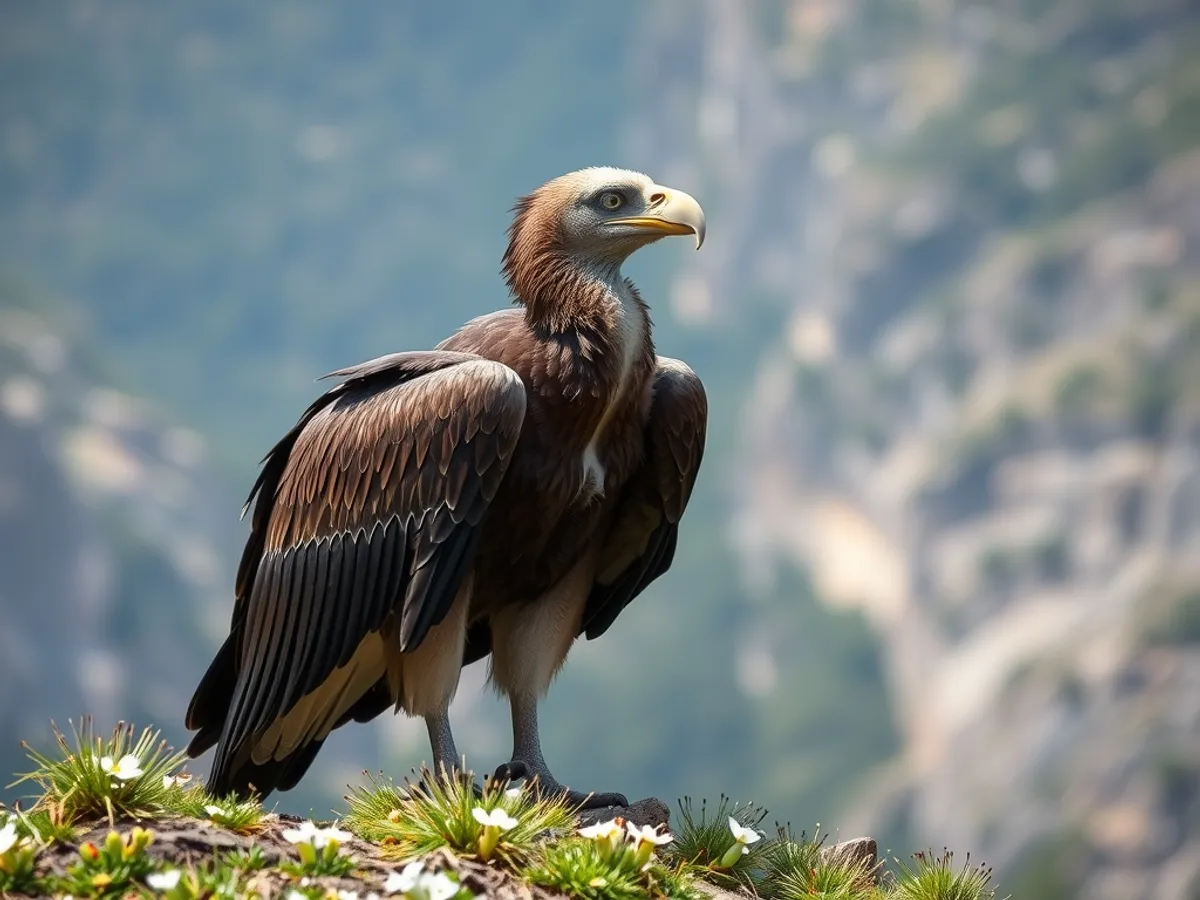
Andean Condor
Vultur gryphus

Meet the Andean Condor
The Andean Condor is one of the world’s largest flying birds, renowned for its impressive wingspan and soaring ability. Native to the high mountains of South America, it is a symbol of power and freedom in Andean culture. This scavenger plays a vital ecological role by feeding on carrion, helping to keep its mountainous habitats clean. Despite its size and strength, the Andean Condor faces threats from habitat loss and poisoning, resulting in its Near Threatened status.
Classification
Bird
Habitat
Mountain
Diet
Carnivore
Lifespan
50–70 years
Conservation
Near Threatened
Weight
11–15 kg
📖Fascinating Facts
Massive Wingspan
The Andean Condor boasts a wingspan that can exceed 3 meters (10 feet), making it the largest flying bird by combined measurement of weight and wingspan.
Nature’s Cleanup Crew
As a scavenger, the Andean Condor feeds mainly on large carcasses of mammals, playing a crucial role in ecosystem health by disposing of dead animals.
High-Altitude Dweller
This species is specially adapted to life in the Andes mountains, often seen soaring at altitudes up to 5,000 meters (16,400 feet).
📋Detailed Description
The Andean Condor (Vultur gryphus) is the largest flying bird in South America and among the heaviest flying birds globally, with males reaching up to 15 kg and a wingspan of up to 3.3 meters. It exhibits striking sexual dimorphism: males possess a distinctive fleshy comb (caruncle) atop the head and are larger than females, which is unusual among birds of prey. The plumage is predominantly black with a characteristic white ruff of feathers around the neck and large white patches on the wings, especially prominent in adult males. Adapted for soaring, the condor has long, broad wings and a high aspect ratio, allowing it to glide on thermal updrafts for hours with minimal energy expenditure. Its head and neck are bare, an adaptation for hygiene, as it often feeds on large carcasses. The Andean Condor is a social species, often roosting and nesting on inaccessible cliff faces at elevations between 3,000 and 5,000 meters. It is primarily a scavenger, relying on its keen eyesight to locate carrion across vast Andean landscapes. Lifespans in the wild are estimated at 50 years or more, and individuals are known for their slow reproductive rates, with pairs typically producing a single chick every two years. This species plays a crucial ecological role as a top scavenger, aiding in nutrient cycling and disease control within its mountainous habitats.
💡 Did you know?
Andean Condors can travel over 200 kilometers (124 miles) in a single day while searching for food.
🔬Research & Sources
Wikipedia Summary
The Andean condor is a South American New World vulture and is the only member of the genus Vultur. It is found in the Andes mountains and adjacent Pacific coasts of western South America. With a maximum wingspan of 3.3 m and weight of 15 kg (33 lb), the Andean condor is one of the largest flying birds in the world, and is generally considered to be the largest bird of prey in the world.
Last Modified: 5/30/2025
🎭Behavior & Social Structure
Andean Condors are diurnal and spend much of their day soaring at high altitudes, using rising thermals to travel long distances with minimal wing flapping. They are highly social outside of the breeding season, often congregating in groups at communal roosts and feeding sites. Feeding behavior is opportunistic; condors rely on their exceptional eyesight to locate carcasses, often following other scavengers or predators. They prefer large mammal carcasses such as those of deer, cattle, or guanacos, but will also feed on smaller animals or marine carrion along coastal regions. Hierarchies are established at feeding sites, with older and larger individuals dominating access to food. Condors are known for their methodical approach to feeding, often waiting for other scavengers to open tough hides before feeding themselves. Daily routines include long periods of soaring, interspersed with resting, preening, and social interactions at roosts.
👶Reproduction & Life Cycle
Andean Condors are monogamous and form long-term pair bonds, often lasting for life. Breeding occurs at high elevations on inaccessible cliff ledges, providing safety from ground predators. Courtship involves elaborate aerial displays, with males performing soaring flights and ritualized dances. The female typically lays a single bluish-white egg every two years, with both parents sharing incubation duties over a period of 54 to 58 days. Chicks are altricial and covered in white down; they are fed regurgitated food by both parents. Fledging occurs at 6 to 7 months, but juveniles may remain dependent on their parents for up to two years. The slow reproductive rate and extended parental care contribute to the species' vulnerability to population declines.
🛡️Adaptations & Survival
The Andean Condor is highly specialized for a scavenging lifestyle in mountainous environments. Its massive wings and high aspect ratio allow for efficient soaring in thin mountain air, minimizing energy expenditure during long-distance travel. The bare head and neck reduce the risk of feather contamination when feeding on carrion, and the skin color can change with emotional state, possibly serving as a social signal. Strong, hooked beaks are adapted for tearing tough hides, while powerful feet, though not as robust as true raptors, aid in gripping carrion. Condors have excellent eyesight, enabling them to spot carcasses from great distances. Their slow metabolism and ability to go several days without food are further adaptations to the unpredictable availability of carrion in their environment.
📚Research Sources
🎨Cultural Significance
The Andean Condor holds profound cultural and spiritual significance throughout the Andes. Revered as a symbol of power, health, and eternity, it features prominently in the mythology of indigenous peoples such as the Quechua and Aymara. The condor is often depicted as a messenger between the earthly and spiritual realms and is a national symbol of several South American countries, including Bolivia, Chile, Colombia, Ecuador, and Peru. Its image appears in folklore, art, and national emblems, and it is celebrated in traditional festivals and dances. However, traditional beliefs have also led to the use of condor parts in folk medicine and rituals, contributing to local declines.
🔬Recent Research & Discoveries
Recent research has focused on the condor's movement ecology using GPS telemetry, revealing that individuals can travel over 200 km in a single day and utilize predictable wind currents to minimize energy costs. Studies of genetic diversity have highlighted regional population structure and the impact of historical bottlenecks. Conservation programs in Argentina, Chile, and Colombia have implemented captive breeding and reintroduction efforts, with mixed success. Ongoing research addresses the impacts of environmental contaminants, especially lead poisoning, and the effectiveness of community-based conservation initiatives. Behavioral studies continue to explore social dynamics at communal roosts and the role of condors in ecosystem health.
🎥Wildlife Videos

Capturing the Sacred Condor in the Andean Highlands | SLICE | FULL DOCUMENTARY
It's been six days since Lucio, old Dimas, and the other men from Cotabambas left their village and began camping at an altitude ...
SLICE

Andean Condor - The Strongest Vulture on Earth
Andean Condor - The Strongest Vulture on Earth Eagles are some of the most impressive birds of prey in the world with a unique ...
WildFacts

PERU - GUARDIANS OF THE ANDES AND THE FOREST | Full Documentary
Explore the wildlife of Peru in this full documentary that reveals the secrets of the Andes and the Amazon. From majestic llamas ...
Wild Nature - English

The Condor's Shadow
The Condor's Shadow profiles a bold and feisty condor named Pitahsi and a larger-than-life biologist with the U.S. Fish & Wildlife ...
Good Eye Films

Soaring with Giants: The Condors of Patagonia
This wildlife documentary follows world-champion hang-gliding pilot Judy Leden on a daring expedition to Patagonia, where she ...
Get.factual

Unique Animal Sightings - My Search For Andean Condors (Nature Documentary)
I travelled 13 hours across Peru then 7 hours through the mountains, all so I could potentially see endangered Andean Condors at ...
Emma Blackwell
🌍Habitat Information
The Andean Condor typically inhabits Mountain environments. Andean Condors have adapted to their environments with specialized features and behaviors.
Primary Habitat:
Mountain
More detailed habitat information will be available soon.
🛡️Conservation Status
The Andean Condor is currently classified as Near Threatened. Conservation efforts are crucial for preserving this species for future generations.
Common Threats:
- 🏠Habitat loss and fragmentation
- 🌡️Climate change impacts
- 🎯Hunting and poaching
- 🏭Human-wildlife conflict
⚠️Threats & Conservation Challenges
Major threats to the Andean Condor include habitat loss due to agricultural expansion, secondary poisoning from ingesting carcasses laced with pesticides or lead, and direct persecution by humans who mistakenly view them as threats to livestock. Illegal hunting and collection of eggs or chicks for traditional medicine or trade also pose risks. The species' low reproductive rate exacerbates its vulnerability to population declines. Population trends indicate significant reductions in many parts of its range, particularly in northern and central Andes, though some southern populations remain relatively stable. Conservation challenges include mitigating human-wildlife conflict, enforcing anti-poisoning regulations, and habitat protection.
🔬Scientific Classification
Scientific Name
Vultur gryphus
Classification Hierarchy
🔍 About Taxonomic Classification
Taxonomic classification is a hierarchical system used by scientists to classify and organize living organisms based on shared characteristics and evolutionary relationships.
The system moves from broad categories (Kingdom) to increasingly specific ones, with each animal's scientific name typically consisting of its Genus and species.
📝Community Notes
Share your observations and insights about the Andean Condor with our community of wildlife enthusiasts.
Join Our Community
Sign in to share your observations and connect with fellow wildlife enthusiasts.
Sign In to ContributeNo community notes yet
Be the first to share your observations about the Andean Condor!
Explore Andean Condor
Select a tab above to learn more about this amazing animal.
📸Photo Gallery
No photos available for this animal yet.
🌟Discover More Wildlife
Continue your journey of discovery with more fascinating animals from our database
